|
This
essay on the aesthetics of ufology grew out of an invitation
by M. A. Greenstein to write a piece for WorldArt magazine on
the subject, specifically – on the relationship between ufology
and the grotesque. Since this aspect of ufology was not my
primary focus, I proposed, instead, a discussion between M.A.
and myself to more fully address her interests. We met twice
and recorded our conversations. After the first audiocassette
was sent to World Art for transcription, the magazine decided
to cut the length of the feature so we never sent the second
recording. Sections of our first conversation were excerpted
and strung together with no editorial input on my part. Even
worse, M.A.’s voice was deleted completely from the final piece,
which resulted in a text that came off as a series of disconnected
proclamations by me on the subject. I was, obviously, not pleased
with this editorial decision. In this new version of the text,
I have combined elements from both discussions. Unfortunately,
the first audiocassette was never returned to us so I was limited
to World Art’s published version of the text as my source. Because
of this, I was forced to emulate World Art’s approach and excise
M.A.’s contribution to the discussion for continuity’s sake.
MK
On
the Aesthetics of Ufology
(excerpted from an interview with M.A. Greenstein)
1997
by Mike Kelley
Ufology
has long interested me as a cultural phenomenon. It has evolved
in many ways since its beginnings in the late Nineteen-Forties
(with the sightings of mysterious air-born lights, the so-called
“Foo fighters,” by Allied bombers over Europe during World War
Two), yet has remained consistent in some regards. I’m particularly
drawn to the stream of ufology where there is an almost utopian
fixation with the hi-tech image of the flying saucer, but this
is paired with an alien being of monstrous form, or other abject
elements. One of the most consistent features of ufology is
this meeting of hi-tech fetishism and symbolic body loathing.
This aspect of it differentiates the concerns of ufology from
a more general cultural fascination with robotics. In most modern
art histories, the aesthetics of technical perfection and those
that relate to images of the deformed body have been set in
counter-opposition. However, in ufology these two aesthetics
are set side by side in a less clear relationship.
Ufology
pictures an aesthetic collision between a housing structure,
the UFO, and an alien element that inhabits this house, in an
uncommon aesthetic mixture of the abject and the technological.
In the Nineteen-Forties, the Wartime framework of the original
UFO sightings rendered the technological aspects of the UFO,
itself, frightening. UFOs were feared as possible examples
of unknown enemy military technology. This concern has faded
over time and the technological aspects of the UFO have taken
on a different symbolic meaning. The clean, orderly, and machinic
nature of the UFO now acts as a foil for the menacing, unformed,
beings that it contains. It is only this, essentially dramatic,
pairing that I would say constitutes the “grotesque” in relation
to ufology. My use of the word grotesque here is meant
to point out the incongruous, and what could at this point be
meaningless, nature of this combination, and is in this sense
a somewhat old-fashioned usage of the term, which was once used
to refer to fantastic decorative motifs. The word, in common
parlance, does not have such playful overtones any more. Nevertheless,
it strikes me as an inappropriate word to apply in ufological
discourse. At present, any discussion of ufology would have
to be understood as one addressing a negative aesthetic. Despite
the fact that the symbolic meaning of its technological component
is unclear at this time, the mythologies of contemporary ufology
are ones of fear and horror. UFO abduction narratives often
describe disturbing intrusionary practices performed upon the
human body. Thus, it seems more proper that ufology be addressed
through contemporary discourses attendant to the abject, and
not the grotesque.
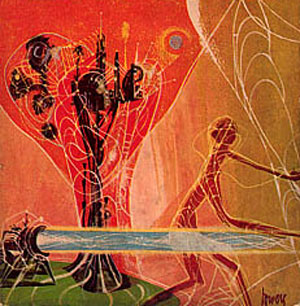
Painting
by Richard Powers; cover of Above
and Beyond by A.E. Van Vogt
Very
few people now hold views similar to those involved in the “space
brother” phenomenon of the Nineteen-Fifties. This group of
UFO devotees drew a comparison between advanced technology and
morals. The assumption was, if aliens have superior machinery
they must, likewise, be more socially advanced. This empathic
notion of the alien was stressed by the fact that they also
looked like us. The film The Day the Earth Stood Still
(1951), which depicts a noble alien who comes to Earth to
save us from our own destructive proclivities, exemplifies this
view of the morally advanced alien and its technology. More
often, however, Hollywood alien invasion films of that period
depict the alien being as evil and totally other, like
the one-eyed blob monster that inhabits the flying saucer in
the film Atomic Submarine (1959). The contrast
between the primordial appearance of such a being and the ultra-sophisticated
device it pilots appeals to me. It prompts the question of just
why there should be such overt design inconsistency between
the form of the being and its craft? The two are so unlike
that they are impossible to reconcile. Its as if I were asked
to believe that the pea soup, or refried beans, that inhabit
a tin can designed that housing for itself, and that this shell
somehow represents its “psychology.” On the symbolic level,
the two forms simply can not have similar meaning.
The
pleasure provoked by this incongruity evokes Georges Bataille’s
aesthetics of heterogeneity. Bataille described the similarity
he felt between such abject excremental forms as sperm and shit,
and the “sacred, divine, or marvelous,” as a byproduct of their
shared heterogeneous status as “foreign bodies” relative to
our assimilating and homogenous culture. They are both, in
a sense, equally taboo. He gives as an example the image of
“a half-decomposed cadaver fleeing through the night in a luminous
shroud”[1]
as one that characterizes this unity. The image of the abject
blob-like alien is part of a long history of images of foul
heavenly masses, sometimes called “star jelly” or “pwdre ser.”
In literary sources and scientific journals spanning the Sixteenth
to the early Twentieth Century one may find descriptions of
“gelatinous meteors” – falling stars that, when located, reveal
themselves as lumps of stinking, white, goo. The evocation of
sperm in such accounts is so obvious that such finds were sometimes
described as “star shoot.”[2] So, a mythic relationship between
the sky and the abject has quite a long history. This conflation
of the heavenly with the abject body recalls Bataille’s example
of the risen Christ, which simultaneously represents rotting
corpse and ascendant being. But, unlike his example, which the
social institution of religion has appropriated into culture
as a divine image, the abject qualities associated with similar
imagery in ufology have maintained their terrifying heterogeneous
nature. Ufology always invokes this connection between the heavenly
and the abject and, so far, this has not been codified to the
point where it could be considered a contemporary religion.
In
Being and Nothingness, Jean-Paul Sartre conducts an analysis
of the “slimy,” attempting to explain why such a quality is
so repugnant. The fact that slime is base, or dirty, is not
the issue. That which is slimy is terrifying, primarily, in
that it provokes an ontological crisis because it clings;
it threatens one’s sense of autonomy, and this is imbued with
an uncanny quality. Sartre writes, “. . .the original bond
between the slimy and myself is that I form the project of being
the foundation of its being, inasmuch as it is me ideally.
From the start then it appears as a possible “myself” to be
established; from the start it has a psychic quality. This
definitely does not mean that I endow it with a soul in the
manner of primitive animism, nor with metaphysical virtues,
but simply that even its materiality is revealed to me as having
a psychic meaning . . .”.[3] Slime’s ambiguous qualities are
accentuated by the fact that its “fluidity exists in slow motion”[4];
it makes a spectacle of its instability. Unlike water, which
instantly absorbs into itself, slime does so slowly giving one
the false impression that it is a substance that can be possessed.
Slime is, therefor, read as a deceitful material. Its in-between-ness,
its boundary-threatening attributes, provokes a base and horrible
sublime experience.
Light,
like water, is generally understood as a kind of transcendental
formless because its undifferentiated qualities are both unitary
and actively kinetic, unlike slime’s earthy weightiness. That
is why it has found such favor in religious imagery in the form
of the halo, and why fixed heavenly bodies, despite their ambiguous
nature and qualities, are not fear inducing. In “documentary”
photographs of UFOs this elevated status is threatened and light
is imbued with negative and terrifying connotations. For, despite
eyewitness accounts that describe “flying saucers” as tangible
technical apparatuses, they rarely have been photographed as
such. Of the innumerable photographs purporting to document
flying saucers collected by the government agency Project Blue
Book[5],
very few reveal any recognizable form. Often, these photos
only show spots of light floating in the sky.[6]
It is not the fact that these photographs image what could be
potentially dangerous technologies in the service of unknown
beings that makes them terrifying, it is their impenetrable
quality that does so. These photographs “picture” that which
cannot be seen - cannot be known. They do so by employing the
sign of the formless – the blob.
Relative
to the image of the alien being, the “unformed” alien is mostly
a product of the Nineteen-Fifties and Sixties. Many Hollywood
films of those eras, and even a few eyewitness accounts, feature
such beings. John Carpenter’s The Thing (1982) (a remake
of the Howard Hawks production from 1951) is one of the few
films after that time to seriously address such a conception.
The film’s shape-shifting alien almost seems like an excuse
to show off the wizardry of the special effects crew. The alien
can adopt any form, and the film’s most chilling moments come
when the being is caught in a transitional phase, between fixed
forms. These “slimy” depictions strike me as overtly psychosexual
in nature. The fact that alien invasion films no longer function
as allegories of Cold War political conflicts, throws the symbolic
meaning of the alien into the realm of, interiorized, psychological
conflicts. The moments when the being is discovered in transition
are definitely “primal scenes” within the film. Watching them,
you feel like the child who has stumbled upon mom and dad in
the act of fucking. You understand this is something you’re
not supposed to see. You don’t know exactly what it is
you have seen, but you know it’s something horrible - the merging
of two distinct bodies into one.
By
the Seventies, the dominant alien type is the childlike “gray”
alien as depicted in Steven Spielberg’s Close Encounters
of the Third Kind (1977). However, abject slimy materials
are still an important element in ufological depictions. The
current literature of alien abduction is rife with abductee
recollections - of immersion in pools of goo by their captors,
of waking to find themselves stained with inexplicable sticky
spots after alien visitations and probings. Less often, the
interior conditions of the alien crafts are described as abject,
as being dirty or foul smelling. This condition is accentuated
in the film Fire in the Sky (1993). The horrific
“in-betweenness” of the slimy in regards to the form of the
alien has been replaced in contemporary ufology with a psychic
in-betweenness – reality becomes liquid as abductees come to
realize that their memories are perhaps only screen memories
implanted by their alien captors. The image of the alien itself
is truly unknowable for it is possible that even that memory
is an implanted fiction. The film Communion (1989) plays
up this aspect of unsure psychic reality by intercutting filmic
“reality” with hallucination scenes so that it is unclear what
the “real” is. The visage of the alien being is presented as
façade - a mask. Reality is indistinguishable from hallucination.
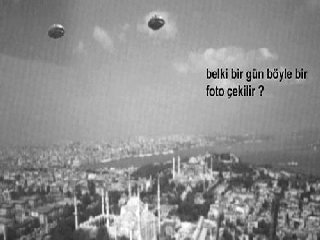
Few
films explore this territory; more often there is a clearly
demarcated division between “our” space and the space of the
alien intruder. Several films of the Nineteen Sixties do explore
this liquidity of space, if only in their “psychedelic” art
direction that pictures biomorphic worlds that themselves teeter
on abstraction. Angry Red Planet (1959) offers an extremely
unusual depiction of the planet Mars, especially given the date
of the film. The scenes on the planet’s surface have been effected
so that they are unnaturally colored and resemble popular psychedelic
graphics of the later Sixties. The visual effects produce a
space that is gooey and indeterminant, and the planet Mars itself,
personified in the form of a giant crawling amoebic organism,
threatens to engulf the space explorers. Barbarella
(1968) is a much more tongue in cheek depiction of psychedelic
space that obvious riffs on contemporary drug culture style.
The evil alien city in the film sits atop the seething “Matmos,”
a shapeless id-organism. This evil manifests itself, humorously,
through sexual perversion in the S&M persona of the city’s
she-witch ruler. The film’s conception of the otherworldly
is dominated by a biomorphic design sense. Interestingly, a
similar ‘alien’ design sense is utilized in the film Fantastic
Voyage (1966) to render the interior space of the human
body – which is revealed as resembling the garish insides of
a lava lamp.
These
visual examples of organic space as depicted in Hollywood films
are reminiscent of the graphic work of Richard Powers, one of
the most active science fiction illustrators of the Fifties
and Sixties[7]. Powers is, by far,
my favorite science fiction illustrator. By the early Nineteen
Fifties, he had broken with the tradition of hi-tech science
fiction illustration, popular since the Thirties, in favor of
a kind of surrealist style. He was alone in this regard. Powers’
illustrations betray the influence of the biomorphic Surrealist
painters Yves Tanguy and Roberto Matta and are extremely abstract.
Figure, environment, machine - are all rendered in a similarly
organic manner so that they interpenetrate each other is a psychedelic
miasma. Powers seems responsible for taking the forms discredited
in the America painting scene by the rise of Greenbergian formalism
- the biomorphic forms of late Surrealist abstraction, and transferring
them to the world of mass culture. It strikes me as obvious
that the success of Powers’ book cover illustrations in the
Fifties paved the way for the explosion of later popular psychedelic
art in the Sixties.
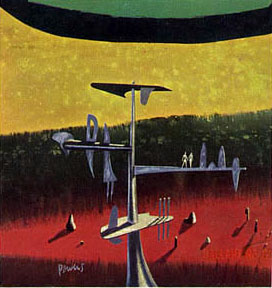
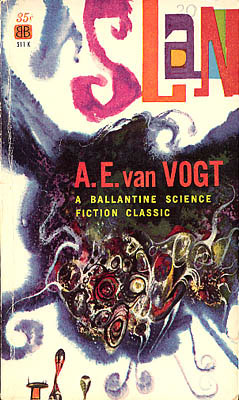
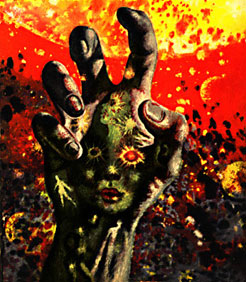
paintings
by Richard Powers
The
rise of the acid-tinged neo-Surrealist pop culture of the Sixties
radically changed the popular notion of the abject; the ‘natural’
was redefined. This is exemplified by the political meaning
of the ‘dirty hippie.’ If you were a hippie, this was understood
as a ‘natural’ condition, if you were not a hippie, this condition
was abject. The popular symbolic representations of disorder,
predicated on images of dirt and defilement, are thrown into
question. This perhaps explains why I so love blob monsters
for, feeling “alienated” myself as a child, I empathized with
them rather than being disgusted by them. Also, since many
blob monsters’ “horrific” nature stems from their thinly veiled
genital appearance, it is only a short step to, as a viewer,
strip this veil away to embrace them as overtly erotic images.
To not do so would be to buy into the repressive sexual attitudes
of those that would depict the genitals as monstrous and alien.
This, perhaps, explains the death of the amoebic aliens of the
films of the Fifties and Sixties and their replacement with
the childlike gray alien of today. The infantile, pre-sexually
conscious, mindset that the “genital” blob alien is directed
toward, has been replaced by one that is sexually conscious
but is fearful of sexual victimization. If these early blob
aliens were “uncanny” in the Freudian sense, that is - they
were genital stand-ins representing castration anxieties (and
this is perhaps confirmed by the number of body part monsters
found in films from this period: the crawling eyes, hands, brains,
etc.), they have been replaced by more overt symbolic representations
of images of child abuse.
As
I pointed out earlier, aliens currently are most often depicted
as childlike beings – small, frail, with oversized heads and
large eyes – almost the cliché Margaret Keane[8]
illustration of the soulful big-eyed waif. But these aliens
are not like our children - they are genderless and asexual
(though they conform in this regard to the stereotypical image
of childhood innocence). They also have no insides and outsides;
because the grays don’t have any orifices we might construe
that they are one pure material - whole. In that sense, the
alien itself could be seen as analogous to Jung’s symbolic interpretation
of the egg-like form of the UFO. He read the UFO phenomenon
as a “collective vision” reflecting a cultural striving for
wholeness and order, represented by the mandala-like shape of
the space ships - a symbolic compensation for the “spit-mindedness
of our age”[9] in the wake of the horrors of World
War Two. Interestingly, Jung explained the societal interpretation
of the UFO as a technological construction as a naturalizing
device, a way to escape the currently out-of-fashion “odiousness
of a mythological personification.”[10]
This aspect of ufology has not changed; the hi-tech image of
the UFO is the same now as it was in the Forties. But the activities
performed inside these ships (primarily beginning with the famed
“abduction” of Betty and Barney Hill in 1961[11])
are quite unlike those depicted in the films of the Fifties.[12]
If the plots in these films reflect the “us vs. them” mentality
of the Cold War period, the new alien abduction scenarios reflect
the battleground of the American family itself. (Though the
recent popularity of the Fifties-style invasion film Independence
Day (1996) signals a possible nostalgic resurgence
of this genre. In this nationalistic fantasy, the unified defense
of the world against alien invasion results in the President
of the United States becoming the President of the World.)
The unchanging image of the UFO strikes me as something of a
conundrum; I would have expected that the technological symbolism
of the UFO would have changed in accordance with shifts in social
symbolism, but this does not seem to be the case. Jung’s reading
of the technological aspects of the UFO as a sign of order remains
firm.
The
scenarios described in UFO abduction accounts are remarkably
similar to the “recovered memories” found in the pop-psychology
literature associated with repressed memory syndrome. This
form of therapy takes as a given the explanation that most adult
emotional problems are the byproducts of, repressed into forgotten,
childhood sexual abuse.[13]
But in ufology the roles are reversed - the childlike aliens
are the abusers of adults. Alien abduction scenarios often detail
painful medical procedures centering on the probing of the body’s
orifices – that which the alien lacks. The abductees are powerless
victims suffering at the hands of emotionless diminuative figures.
Obviously, the similarity of the scenarios found both in “recovered”
memories of childhood abuse and alien abduction accounts points
toward a cultural crisis regarding notions of childhood, sexuality,
and power. Even figures within the world of ufology itself now
say that recovered memories of alien abduction are perhaps only
symbolic, though they also believe that this aspect of the abduction
“phenomenon” is promoted by, and in the service of, the aliens.
Jacques Vallee[14]
writes, “We are compelled to conclude that many abductions are
either complete fantasies drawn from the collective unconscious
(perhaps under the stimulus of an actual UFO encounter acting
as a trigger) or that the actual beings are staging simulated
operations, very much in the manner of a theatrical play or
movie, in order to release into our culture certain images that
will influence us toward a goal we are incapable of perceiving.”
[15]
If
the UFO phenomenon reflects, as Jung puts it, “the split-mindedness
of our age,” it could perhaps be understood to parallel (though
on an unconscious level) the “schizo-cultural” aspirations of
Gilles Deleuze and Felix Guattari, whose notion of the “body
without organs” could be applied to the uniform materiality
of the orifice-less alien. Though they, surely, would not empathize
with the pathological reading applied to this current wave of
hallucination. Delueze and Guttarri’s image of the body without
organs is a reaction against the mechanization of the body induced
by conventionalized usage of the organs of sense. As they put
it, “Is it really so sad and dangerous to be fed up seeing with
your eyes, breathing with your lungs, swallowing with your mouth,
talking with your tongue, thinking with your brain, having an
anus and larynx, head and legs? Why not walk on your head,
sing with your sinuses, see through your skin, breathe with
your belly . . .”[16]
Well, yes it is sad if these experiences are simply reducible
to symptoms associated with a group hallucination reflecting
a culturally regressive desire to hold on to outmoded idealized
notions of childhood purity.
At
this point I want to make a U-turn and go back to my previously
stated interest in the blob alien, and my contention that this
could be viewed as an “erotic” image – a fanciful depiction
of, rather than a fearfully sublimated image of, the genitals.
For this to be true, the appeal of the image could not be simply
limited to a perverse reading – that the blob alien is a “dirty”
image that represents a conflation of sexual notions with ones
of defilement. The latter idea would probably be in line with
the original intentions behind the design of such creatures,
but I would like to argue that we are not limited to such a
reading. Now, Sartre’s analysis of the slimy most definitely
addresses the sexually horrific overtones of such substances,
whose clinging qualities he designates as feminine. The female
genitals, and in fact all holes, provoke in him the same fear
of being swallowed up. The conclusion would be that he must
find the sexual act of penetration to be exceedingly horrific.
He especially disdains the “sickly sweet, feminine” and states
categorically that “A sugary sliminess is the ideal of the slimy.”[17] Even so, Sartre
seems to be saying that there is really no hierarchy of sliminess
– sticking ones hand into a pot of honey provokes the same amount
of revulsion as sticking it into a pot of gooey pus. This doesn’t
ring true to me.
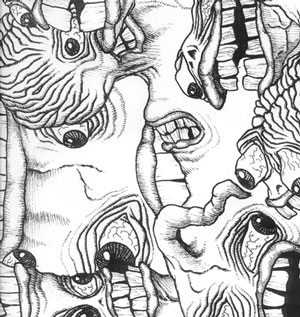
The
anthropologist Mary Douglas makes a point somewhat similar to
Sartre’s, in that she points out that filthiness is not a quality
in itself but is a byproduct of a boundary disruption. However,
notions of boundary operate here on several levels. She states,
“Matter issuing from them [the orifices of the body] is marginal
stuff of the most obvious kind. Spittle, blood, milk, urine,
faeces or tears by simply issuing forth have traversed the boundary
of the body.”[18] The problematic
nature of these materials is not so much their phenomenological
qualities (as Sartre would say of the slimy) but that they are
confusing materials, being both part of you and separate from
you. This is similar to Sartre's slime, that provokes an ontological
crisis in its clinging insistence that it is part of you when
it obviously is not. But following on her statement regarding
materials issued by the body, Douglas makes a second point,
“The mistake is to treat bodily margins in isolation from all
other margins.”[19] This notion of boundary is less specifically ontological
and more one of definition and framework – abject qualities
are defined by context. A simple example would be - dirt in
the house is bad, dirt in the garden is good. This notion of
boundary is less all-encompassing than Sartre’s phenomenological
approach and allows for argument about proper usage and definition
of boundaries.
Now,
relative to Douglas’ list of abject bodily materials, it seems
obvious to me that most would agree that some of these materials
are more abject than others are. Very few people would truly
find tears abject at all, and only the most squeamish would
find mother’s milk abject – in any context. I found myself
thinking about this relative abject-ness in relation to pornographic
depictions, specifically the image of male ejaculation, the
so-called “money shot,” and especially the photographic image
of the face with sperm upon it. This image has become a mainstay
of pornographic iconography since the success of the first pornographic
feature film, Deep Throat (1972). My interest
in this image grew out of the question of whether it was possible
to have a sexualized depiction of a blob that was not an image
of defilement. And I would have to answer that yes, I do think
this is possible. Is a photograph of a puddle of sperm, by
itself, abject? Is it necessarily an image of defilement?
Some would find it so, some wouldn’t. Only the most sexually
conservative people, who feel that intercourse is only to be
performed in the production of children, would have such a mechanistic
view of sex as to argue that any visible trace of sperm would
constitute a transgression. Obviously, for many others, the
experience of the gooey-ness of sperm is tactilely pleasurable,
is part of normal sexual activity, and has no negative overtones
whatsoever.
The
money shot has been roundly criticized as an act of defilement
of the female countenance, but is it truly so?[20] Its presence in pornographic films is easy to
explain – it proves that male orgasm has occurred, and this
is located in proximity with the traditional site of female
displays of ecstasy: the face. Male and female orgasm is presented,
in one frame, as simultaneously visible. Pornographic films
are participatory; they are designed specifically for men to
masturbate to. The male viewer’s fantasy investment in them
is predicated on their “documentary” nature – that they are
“real” displays of pleasure, which is proven by the visible
act of ejaculation. The viewer’s pact with a pornographic film
is predicated on this shared experience with the surrogate version
of himself acting in it.
An
amusing result of the rise of the money shot in pornography
is the result it has had on the reading of earlier “spiritualist”
photography, specifically the genre of photograph that depicts
the medium exuding “ectoplasm,” a white substance that it said
to flow from the orifices of a medium in a trance. A photo
of the medium Mary M., taken in Winnipeg in 1929, shows the
cotton-like material caught in the female medium’s hair, and
pouring from her ears, nose, and down her chin onto her breast.
Her eyes are rolled up in the ecstatic pose familiar from pornographic
photos from the same period, a gesture that seem derived from
ecstatic countenances found in Christian religious imagery.[21]
Another photograph depicts the material running from between
the medium’s legs into a heap on her feet.[22]
The sexual connotations of such imagery is so obvious that it
could not be produced now without it looking like it was designed
specifically to reference the money shot, a pornographic trope
that was not even present in pornographic photography of the
Twenties. The fact that these photographs strike us as funny
reveals the fact that such overt sexual connotations are incompatable
with spiritualist imagery, that the “sexualizing” of an image
is a form of defilement. On the other hand, our present problem
with ectoplasm photographs could simply be that the displays
of ecstasy depicted in them strike us as too mannered to be
believable at this time – that they are not convincingly
erotic. If it weren’t for that fact, perhaps such imagery
could maintain its transcendental value despite its sexual overtones.
I prefer this second interpretation; if it is true, then my
desire for erotic depictions of blob monsters is a possibility.
UFO
photography has taken the place of early Twentieth Century spiritualist
photography as the dominant mode of supernatural imagery. The
fact that many UFO photographs look as obviously faked as ectoplasm
photographs (a fact that can be forgiven in spiritualist images
since photography was still invested with truth value in the
early Twentieth Century) doesn’t really matter. These are images
of faith more than they are “documentary” photographs, and in
that sense UFO photographs are a true folk art form representing
what are, at this point, traditional and commonly held beliefs.
Still, as I stated earlier, this belief system has not yet been
appropriated into mainstream culture in a “homogenized” way.
It does not yet function analogously to a true religion. Despite
the commonplace nature of the UFO mythology at this time, it
is still held in disdain, still considered a “crackpot” belief
system. As such, it maintains its “heterogeneous” cultural
position and its terrifying overtones.
|